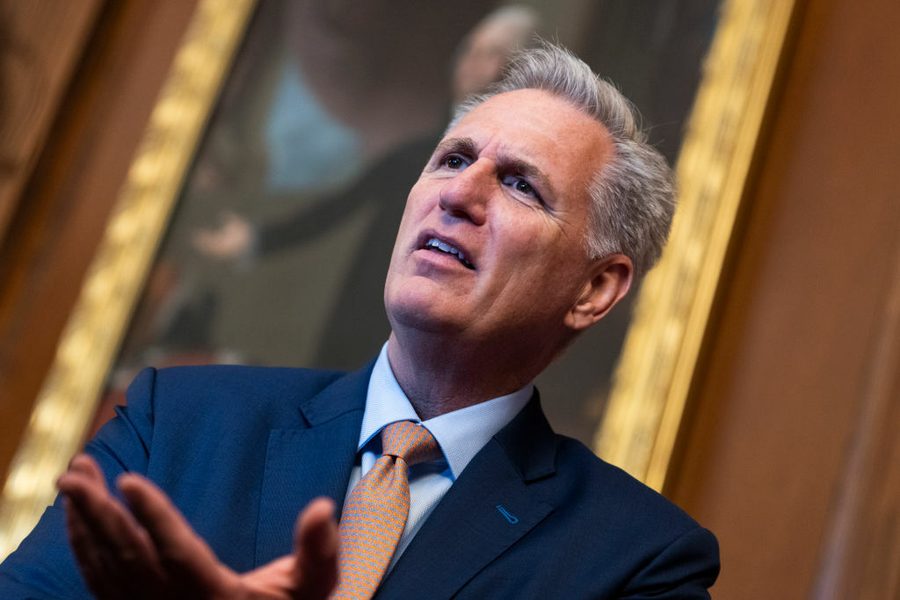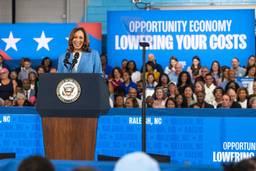Democrats Shouldn’t Fall for McCarthy’s Debt Limit Ransom Attempt
Republicans are threatening to tank the global economy if President Biden doesn’t agree to slash spending on social welfare programs. It’s a trap.
Max B. Sawicky

Contrary to some expectations, Speaker of the House Kevin McCarthy (R-Calif.) has managed to unite his caucus around an austerity plan dubbed the “Limit, Save, Grow Act,” which is being used as ransom for not blowing up the economy with a debt default by the U.S. government. Democrats are charging that the plan would cut benefits to veterans and food stamp recipients, among others, while Republicans have issued outraged denials. So what’s really going on?
McCarthy is accusing President Biden of endangering the economy by refusing to negotiate on the debt ceiling. Of course, it would be easy for the ceiling to be lifted absent the obstruction by McCarthy himself. His is the “stop me before I kill again” strategy.
Republicans routinely fail to agree on, let alone enact, specific stand-alone spending cuts that match their rhetoric on deficit reduction. They are forced to resort to extortion that exploits the need to approve a lifting of permitted U.S. national debt. McCarthy’s bill cannot pass the Senate, but he thinks it provides him leverage in negotiating with the White House. Biden, meanwhile, has asserted that he will not negotiate on the debt ceiling.
The need to continue borrowing is founded, it should be noted, on spending that was already approved by Congress. As with electoral defeats, the Republicans would like the opportunity to stage do-overs of votes they have already lost. In and of itself, raising the debt ceiling is not synonymous with new spending increases.
A failure to raise the debt ceiling is feared to impede the federal government’s ability to pay its bills, including interest due on bonds held in the private sector. Failure to pay interest due, on time, would represent a default — the global financial implications of which are unknown, and possibly catastrophic.
The debt ceiling is a legal fact, but it is directly contradicted by an alternative fact: the U.S. Constitution stipulates that the government must make good on its debts. So one suggested resolution of this conflict is for the Treasury to simply ignore the debt ceiling and go on about its routine operations.
A more exotic remedy, also based in law according to some authorities, is that the Treasury may legally mint a platinum coin of any denomination — something perhaps in the trillions of dollars — and claim the implied purchasing power to meet its financial obligations. The coin gambit may sound nutty and would probably provoke a political furor, but that doesn’t mean it can’t work.
What about the Republican cuts? The key to understanding their method is that they want to avoid leaving any fingerprints on unpopular reductions in benefits or services. To this end, they explicitly rule out major categories of federal spending, such as defense, Social Security and Medicare. (Interest on the debt is automatically out of bounds.)
The trick is what they implicitly rule in: most of what’s classified as “non-defense discretionary spending.” If you start with the assumption that huge cuts are necessary, and you then rule out the biggest components of the federal budget, you put enormous pressure on a narrow category of social programs. Non-defense discretionary spending is about 14% of total outlays. The Republicans claim that it is possible to gouge the entirety of their deficit reduction out of this component of federal spending.
The Republican plan would subject its targeted spending to caps rolled back to fiscal year 2022 spending levels, with increases limited to 1% annually. The reality is that programs already in place would naturally grow in cost, due to the increasing size of the job to be done, and due to ordinary inflation that usually exceeds 1%. Hence a cap stipulated in dollar terms not, at the very least, adjusted fully for inflation, automatically amounts to a cut.
Spending on veterans, among other popular programs, is not exempted from possible cuts, but neither is it specifically reduced. The way it works is that non-defense spending is put in a box with the specific decisions on how much and where to cut left for later, in the obscure deliberations of Congress’s appropriations committees. If one applies the cuts implied by the spending caps across-the-board, then you can begin to derive the implications for every specific program of non-defense discretionary spending, i.e. a disastrous
human toll. These implications are what Republicans would like us to ignore.
The McCarthy plan is best understood as a set of talking points, not unlike the sort of policies concocted by the Trump administration. Instead of actual policies, Trump’s minions would craft press releases with bullet points aimed at scratching particular itches. Propaganda on behalf of McCarthy’s gambit is streaming out of the Committee for a Responsible Budget, contemporary heir to the panic stories circulated by the Concord Coalition and others which claim that we are on an unsustainable fiscal path. But these people have been saying that since the 1980s.
Another unwelcome endorsement of the McCarthy scam has come from Trump’s former chief economist, Kevin Hassett, who discounts the hazards of an imminent default on U.S. debt. It is true that a default could amount to a big nothing, but it could also be quite the contrary. Nobody with any sense wants to find out for certain, as the negative effects would largely be borne by working people.
The Republican plan includes some frivolous items founded in pure politics that have little to do with debt reduction. One is a commitment to hastening the institution of work requirements for Medicaid, which nobody thinks matters for the overall costs of the program. While the plan attacks such means-tested benefits for Medicaid’s 93 million beneficiaries, it does indulge welfare for wealthy farmers, in the form of subsidies for biofuels.
Another clownish initiative in McCarthy’s plan is reversing the Biden administration’s move to increase the IRS budget. Such a reversal would actually increase public debt, not lower it. Improved IRS enforcement would reduce the extent to which federal taxes are left unpaid, or not paid on time. The rate of non-payment, known as the “tax gap,” is estimated at roughly one in six dollars. Of course those most likely to avoid taxes are big corporations and the ultra wealthy, who also contribute to GOP candidates.
Braying about the deficit has not discouraged Republicans from proposing further tax cuts. As recently as last October, they supported extended tax cuts first enacted during the Trump administration. Despite their anguish over the public debt, Republicans still want more tax cuts for corporate America.
The Democrats’ invocation of a threat to veterans’ benefits, more than anything else, bespeaks a defensiveness that does not do justice to the broad gamut of federal programs. So too with the effort to cite Republican tax cuts as an important factor in the growth of public debt. It has been an important factor, but this political argument has not worked for 40 years. Democrats thought they could mousetrap Ronald Reagan with it. That never happened.
The future of welfare spending will depend on public support for what it does, not by relying on nostrums about how taxing the rich will relieve the average person of paying for what should be seen as worthwhile in its own right. Democrats should be steadfast and clear-eyed in their defense of social programs, no matter the hostage-taking tricks played by Republican leadership.
Max B. Sawicky is an economist and writer in Virginia, formerly with the Government Accountability Office and the Economic Policy Institute. He is a Senior Research Fellow at the Center for Economic and Policy Research and runs the MaxSpeak, You Listen! blog at sawicky.substack.com.








